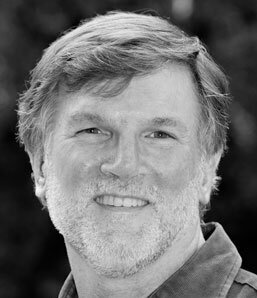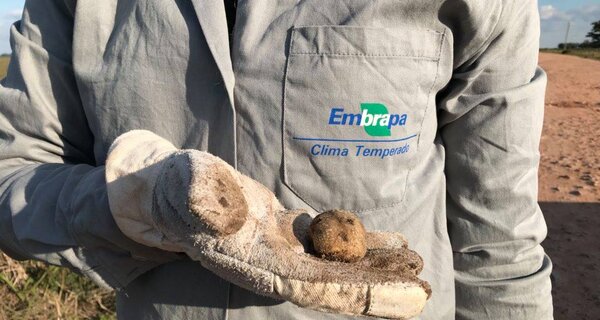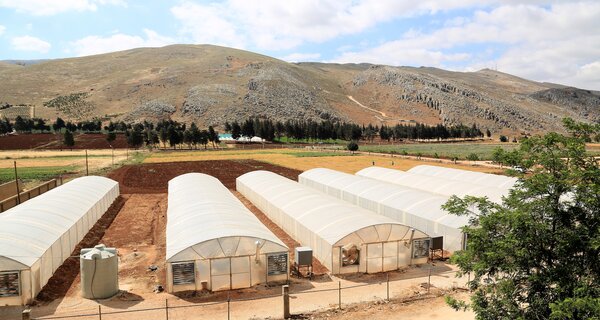Regenerating Wild Crop Relatives in the Fertile Crescent
 Collecting wild wheat seed from regeneration plots at the American University of Beirut's AREC station near ICARDA's Terbol station in Lebanon’s Beqaa Valley. (Photo: Michael Major/Crop Trust)
Collecting wild wheat seed from regeneration plots at the American University of Beirut's AREC station near ICARDA's Terbol station in Lebanon’s Beqaa Valley. (Photo: Michael Major/Crop Trust)18 September 2018
ICARDA is regenerating massive amounts of crop wild relatives in their place of origin – the Fertile Crescent
Ahmed Amri selected a spike from a collection he held in his hand. “This one is what we think is the progenitor of wheat. It’s Aegilops speltoides.” Ahmed, the head of Genetic Resources at the International Center for Agricultural Research in the Dry Areas (ICARDA) then held up another spike. “And it crossed with this one: Triticum uratu.” Ahmed continued to place wheat spikes in a line on the ground and mapped out the evolution of durum and bread wheat over the millennia.
On the ground lay an amazing collection of wheat genetic diversity … all freshly picked from the regeneration plots of ICARDA at its Terbol station in Lebanon. It was as if time had been turned back, and the evolution of wheat had been repeated all over again, right here in its center of origin.
The area is not only the center of diversity of wheat. The wild progenitors of barley, flax, chickpea, pea and lentil are all still found in the so-called “Fertile Crescent,” which forms an arc from the Nile delta to the head of the Arabian Gulf. It was here that the first crops were domesticated more than 10,000 years ago.
It’s no coincidence that ICARDA’s Terbol station is located right in the middle of an area known as one of the very few original homes of agriculture around the world.
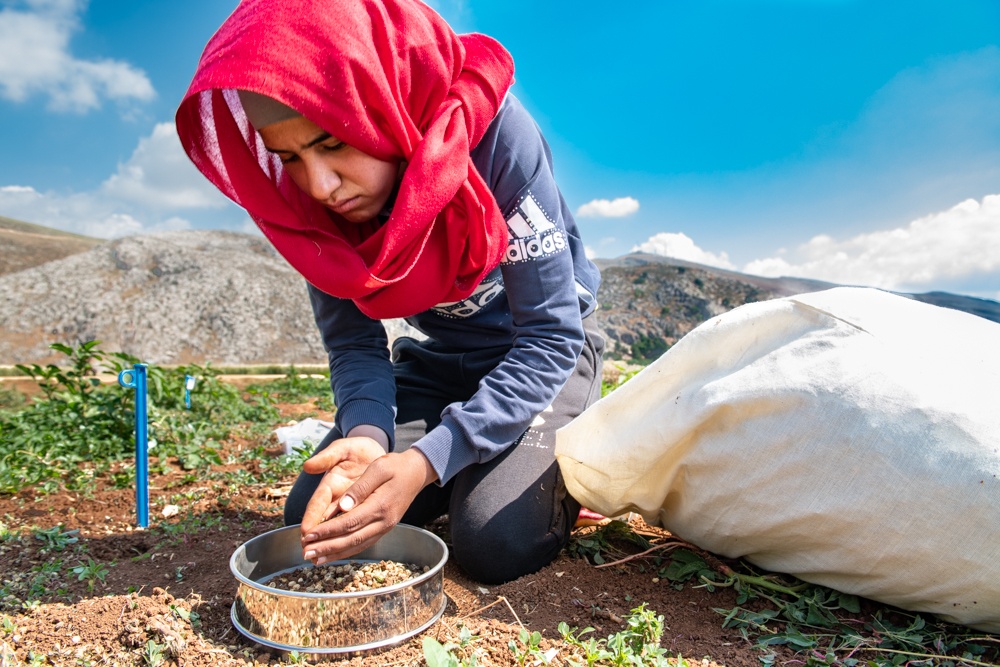
Seed from some crops like "Medicago" have to be painstakingly collected by hand in the field. Amina Jomaa collecting "Medicago" seed in regeneration plots. (Photo: Michael Major/Crop Trust)
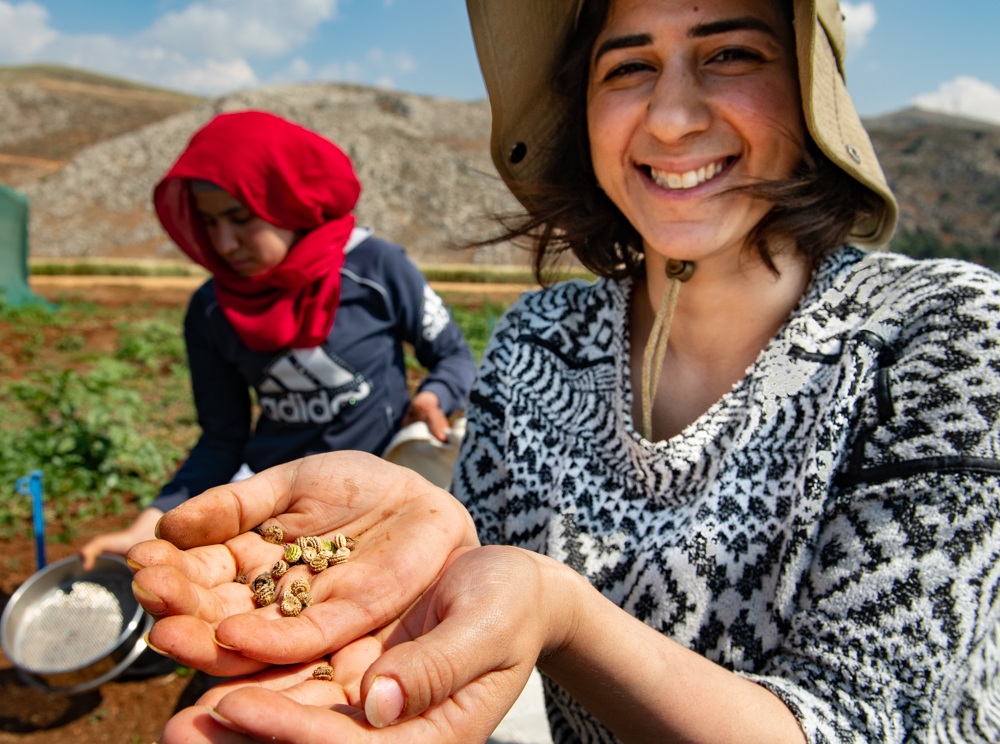
Jostelle Al Beyrouthy. Collecting Medicago seed in regeneration plots of ICARDA Terbol. (Photo: Michael Major/Crop Trust)
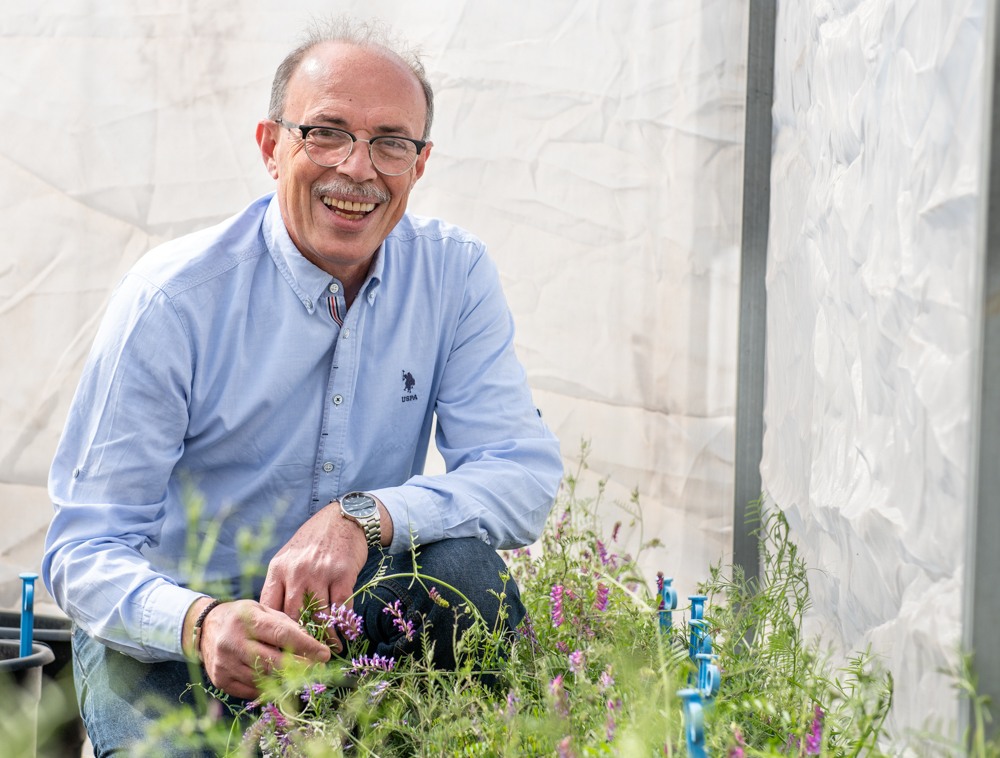
Curator of Forages and Range Species Dr. Ali Shehadeh in an isolation cage. (Photo: Michael Major/Crop Trust)
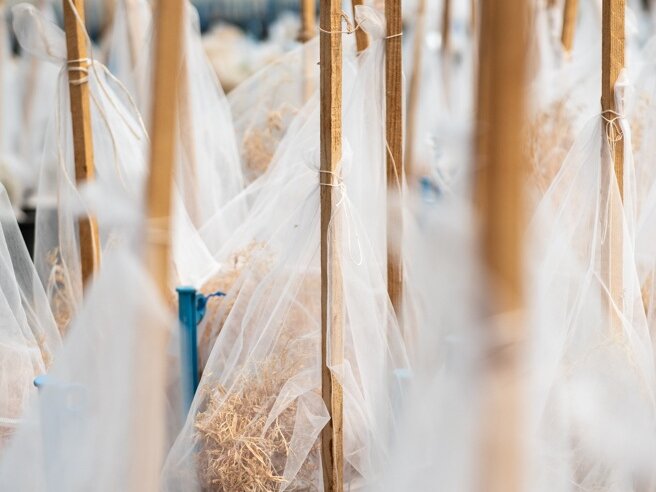
Some forage and range species need to be planted in pots in plastic houses since they shatter their seeds when mature. Mesh bags are used to catch the dropped seeds. (Photo: Michael Major/Crop Trust)

Cross-pollinated crops like faba bean and grasspeas ("Lathyrus" spp.) are regenerated in isolation cages. (Photo: Michael Major/Crop Trust)
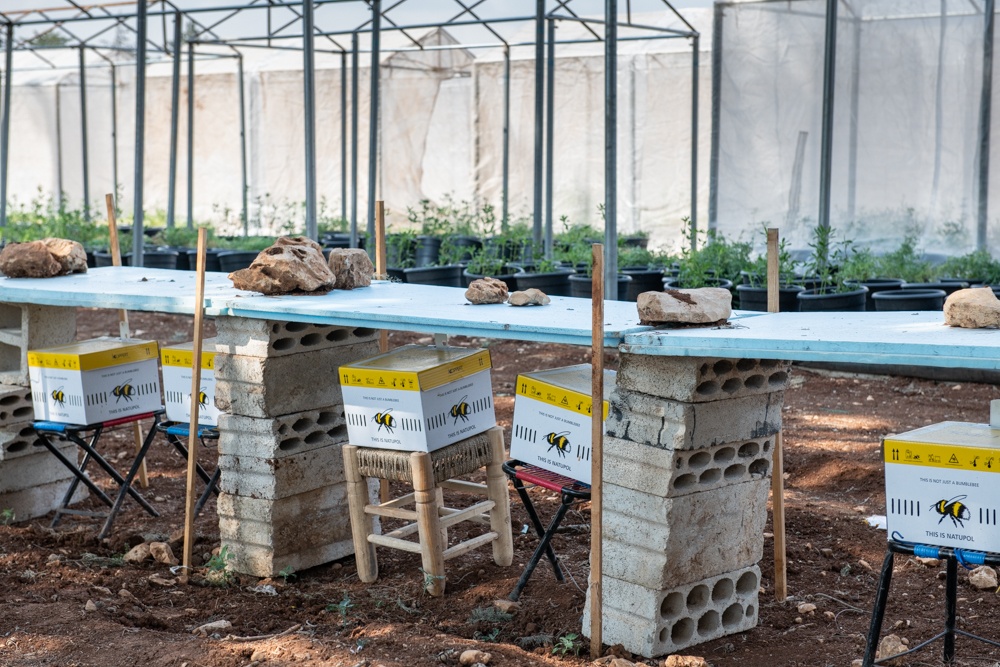
Isolation cages for cross-pollinating but self-incompatible species which require pollinators. Bumblebees are imported from The Netherlands. (Photo: Michael Major/Crop Trust)
Regenerating Crop Wild Relatives
Plant genetic resources scientists from ICARDA have been scouring the Fertile Crescent for these wild relatives of our domesticated crops for the interesting traits that they hold. In order to conserve this genetic diversity in the long term, they must have an abundance of seeds in active and base collections of the genebank and also safely duplicated in another genebank, and the Svalbard Global Seed Vault. That can mean a lot of seeds have to be regenerated from the handful gathered by the original collectors. That’s not so easy to do. The seeds of crop wild relatives are tricky to germinate, harvest, thresh and clean.
But ICARDA has developed the expertise and technology to regenerate thousands of these seeds at its Terbol station. The current work is a massive operation: 9,603 separate samples, or seed samples, were multiplied at Terbol in 2017 and 14,244 in the 2018 growing season, a number bigger than the entire collection of many genebanks. In addition, ICARDA is regenerating wheat seed samples sent by the International Maize and Wheat Improvement Center (CIMMYT). The Millennium Seed Bank at Kew Gardens (MSB) has sent a significant number of seed samples for regeneration which were collected in the Fertile Crescent as part of the ongoing Crop Wild Relatives Project.
Until 2012, ICARDA conducted most of its genetic resources work in Tel Hadya in Syria. But with the ongoing conflict in Syria, the Center upgraded its Terbol station to handle many of its genebank operations. “ICARDA now operates genebanks in both Lebanon and Morocco. Much of the regeneration work of the crop wild relatives and wild forage and range species is done in Lebanon,” Ahmed explained. “This is the center of diversity of these crops. This is no doubt the best place in the world to undertake such a massive task.” Terbol lies in Lebanon’s Beqaa Valley and is ideal for growing seeds with different requirements as it provides a gradient of conditions from semi-desert to high-rainfall areas.
One problem with regeneration work is the seed invariably will escape. “If a seed of a wheat wild relative escapes in Mexico, it could very well become a noxious weed,” Ahmed says. “In Morocco, we would have to multiply indoors and that’s not economically viable.” In Lebanon, ICARDA can multiply a large number of seed samples outdoors in their natural habitat without the precautions needed to prevent introducing weeds.
But regenerating seed in large quantities is challenging given the high standards required in seed multiplication for genebanks.
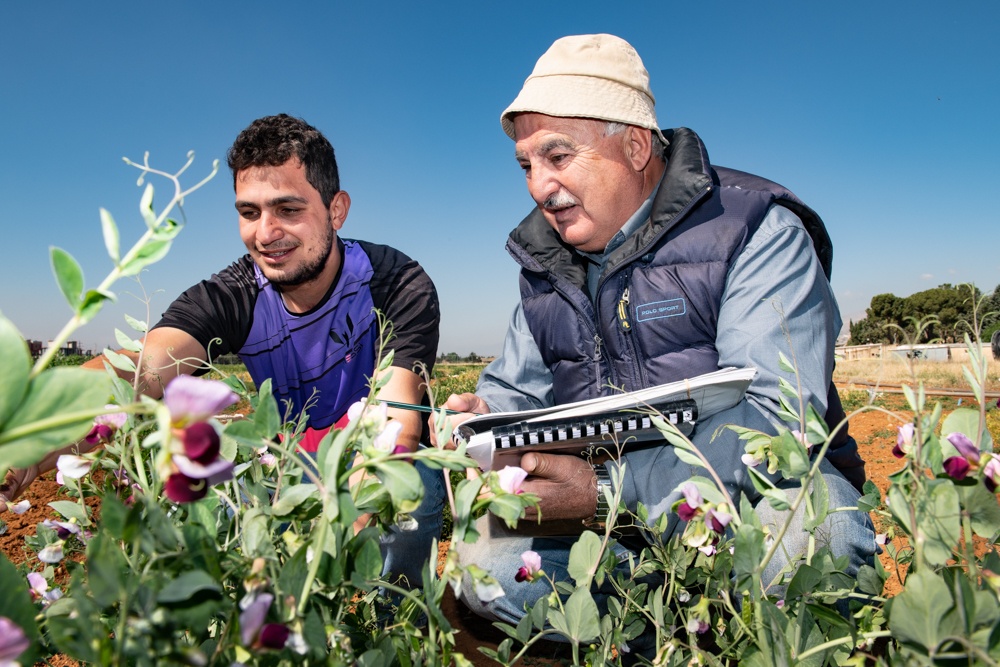
Fawzi Sweid (right) sharing his experience in characterization learned over 30 years at ICARDA with Bachir Al-Awar (left) at the seed regeneration plots at American University of Beirut’s AREC station near ICARDA’s Terbol station in Lebanon's Beqaa Valley. (Photo: Michael Major/Crop Trust)

Hand harvesting in the seed regeneration plots at the American University of Beirut’s AREC station near ICARDA’s Terbol station in Lebanon’s Beqaa Valley. (Photo: Michael Major/Crop Trust)
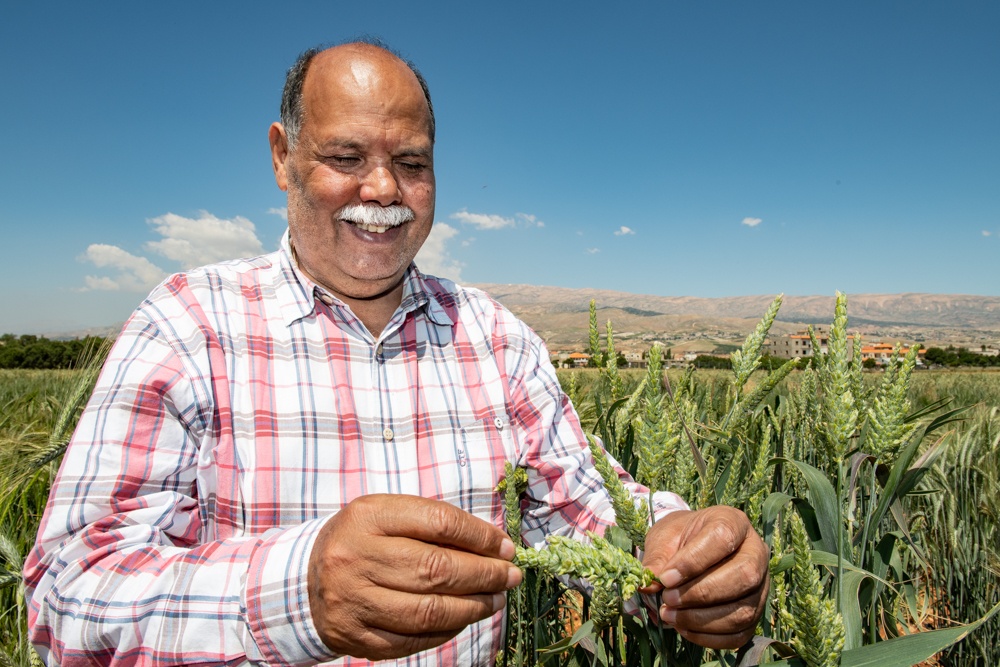
Dr. Ahmed Amri, Head of the Genetic Resources Unit, reviews seed regeneration plots at the American University of Beirut’s AREC station near ICARDA's Terbol station in Lebanon's Beqaa Valley. (Photo: Michael Major/Crop Trust)

Dr. Mariana Yazbek, Genebank Manager, Lebanon in the seed regeneration plots at the American University of Beirut's AREC station near ICARDA’s Terbol station in Lebanon’s Beqaa Valley. (Photo: Michael Major/Crop Trust)
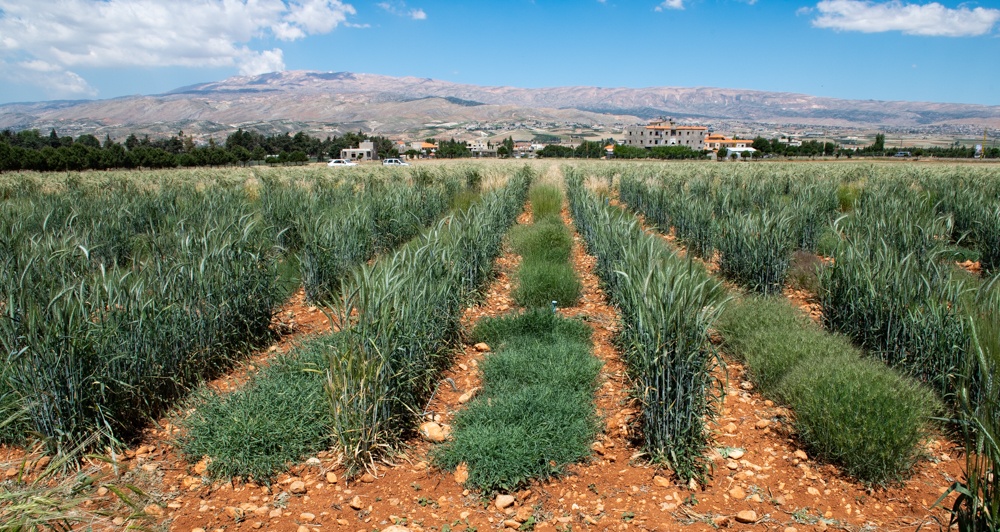
Seed regeneration plots of wild wheat and 'Aegilops' at the American University of Beirut’s AREC station near ICARDA’s Terbol station in Lebanon's Beqaa Valley. (Photo: Michael Major/Crop Trust)
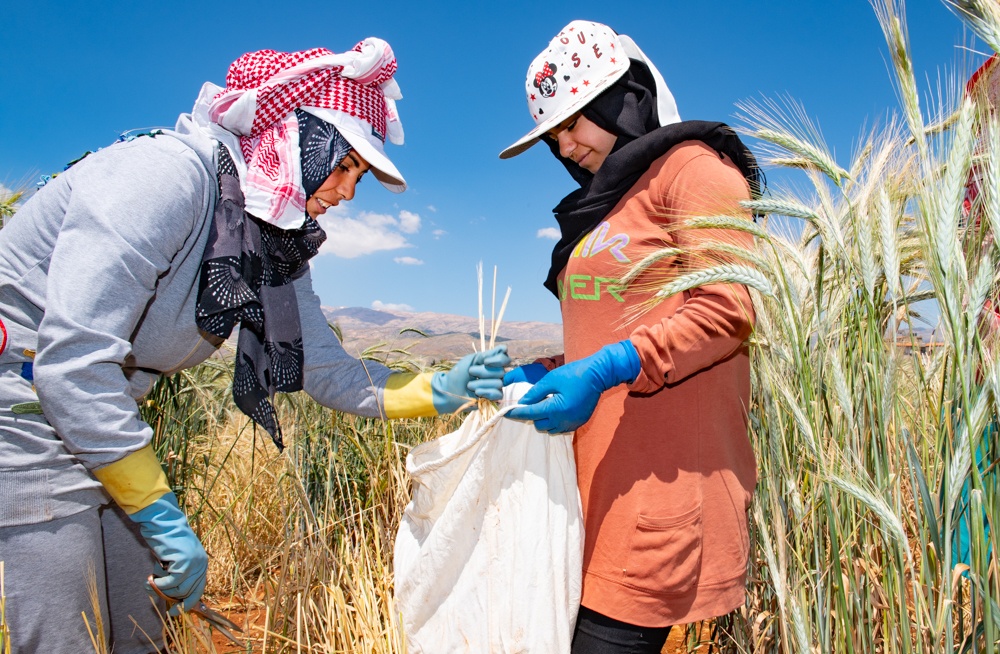
Collecting wild wheat seed from regeneration plots at the American University of Beirut's AREC station near ICARDA's Terbol station in Lebanon’s Beqaa Valley. (Photo: Michael Major/Crop Trust)
Maintain Integrity, Quantity and Viability
“We have three fundamental goals in our regeneration program: integrity, quantity and quality, in terms of health and viability,” said Dr. Mariana Yazbek, manager of the Terbol genebank. “First, we want to ensure we have the integrity; that is, the seed sample has conserved its original identity during the process of regeneration and conservation. Selection pressures, outcrossing, mechanical mixtures and other factors can all affect integrity.”
Taxonomic identification has proven to be a mounting issue. “In some cases, we notice that 30-40% of the seed samples we receive to multiply have been incorrectly identified,” Mariana said. “So, our staff have to have a keen eye for taxonomy to ensure that what’s in the packet is indeed what it says on the label!
“Secondly, we need to generate a quantity of seed sufficient to stock our active and base collections. This means having enough seed to distribute to our partners and to safety duplicate while still keeping enough seed in conservation,” Mariana said. “So, we’re not talking about producing a few handfuls of seeds; we’re talking about thousands of seeds of each seed sample.
“Finally, we need to make sure that the seeds are viable – that they will germinate when planted again and they do not carry diseases and pests that are quarantine risks,” Mariana said. For that too, ICARDA is well placed, with skilled staff to ensure that healthy seeds are harvested on time and moved rapidly to storage, using well-rehearsed standard operating procedures.
It’s hard enough though to maintain integrity, quantity and quality for a single seed sample. ICARDA has to do it for more than 150,000 seed samples.
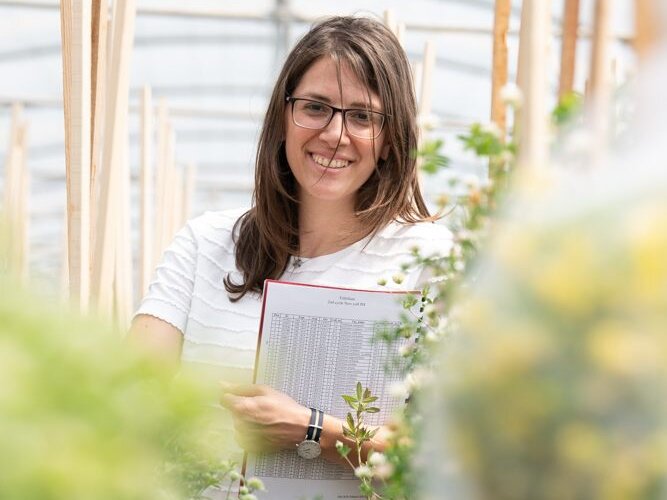
Joud Kayyali began working at ICARDA 13 years ago in Syria. She re-joined ICARDA in Lebanon to continue her work as a research technician in forage legume and range species crops. (Photo: Michael Major/Crop Trust)
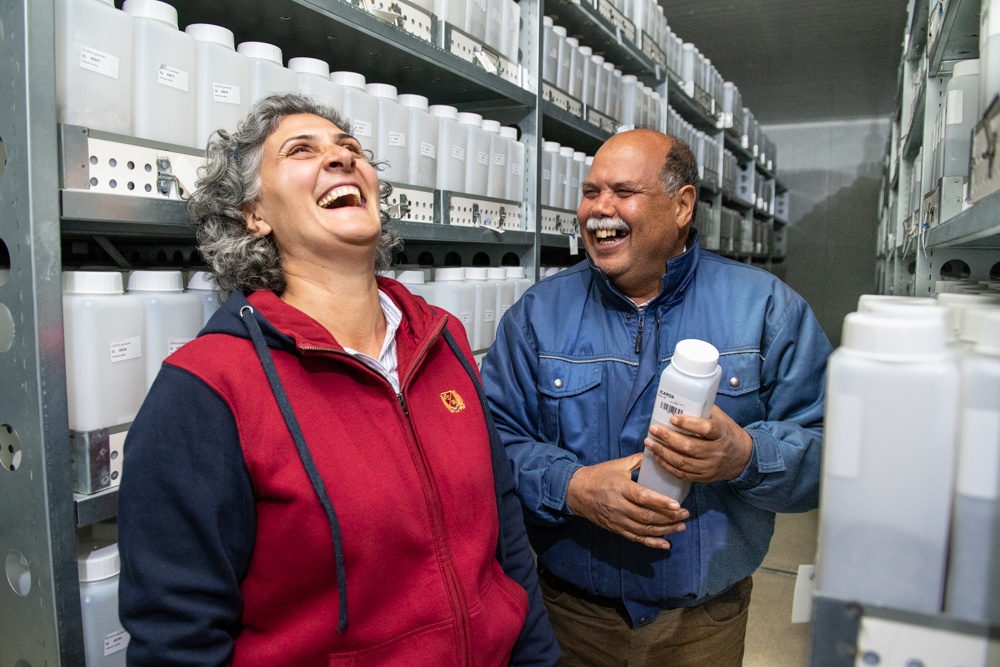
Mariana Yazbek and Ahmed Amri in the active collection of ICARDA's genebank at Terbol station in Lebanon's Beqaa Valley. A new genebank was opened in Terbol in 2016. (Photo: Michael Major/Crop Trust)
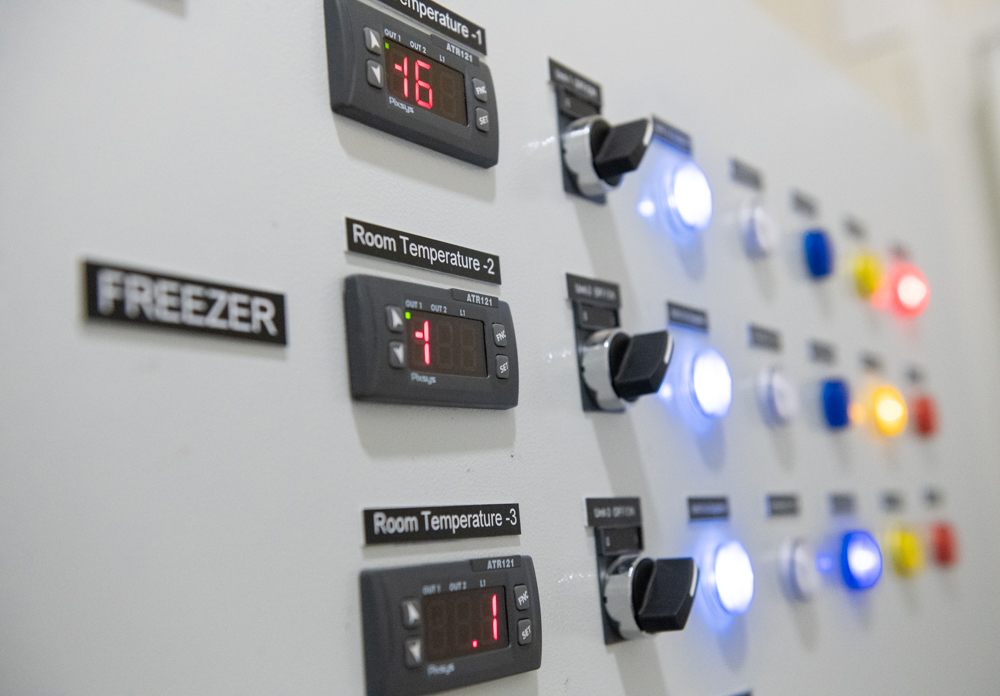
ICARDA’s genebank at Terbol station in Lebanon’s Beqaa Valley was inaugurated in September 2016. (Photo: Michael Major/Crop Trust)
Matching the Crop with the Method
When it comes to multiplying crop species from the Fertile Crescent, it isn’t a matter of “one method fits all.” Different crops require different methods for seed multiplication. ICARDA deals with a large number of species, and all require their own regeneration protocol. Sometimes, even varieties within species do.
“We are set up to handle four major groups of crops,” Ahmed said. “First, we have crop species that are self-pollinated.” These are crops like barley, wheat, chickpea and lentil where pollination occurs within each individual plant. “These are the easiest to maintain in terms of ensuring integrity. Genetic material won’t be transferred between seed samples.” ICARDA leases land from the American University of Beirut’s Agricultural Research and Education Center a few kilometers north of Terbol for this regeneration, multiplication and characterization work.
Self-pollinators needing a bit more hands-on attention because of the limited seed available are kept in plastic houses in Terbol. Some not-so-domesticated species need to be enclosed in mesh bags since the seed heads tend to shatter.
“The second group of crops we work with are the cross-pollinated crops like faba bean and grasspea,” Ahmed said. “The integrity of the seed sample is at risk if we’re not careful, as we can get pollination between seed samples. For these species, we work in isolation cages and we keep any potential insect pollinators out.”
ICARDA has constructed 40 isolation cages of green mesh, which measure 24 by 16 meters. Seed Samples in these cages are planted in two or three rows with row spacing of 45 cm and 1.45 m between two adjacent seed samples.
“Then we’ve got some cross-pollinated species which are self-incompatible, such as some wild forages like Trifolium,” Ahmed said. “That means if you don’t have insects to pollinate them, you will get hardly any seeds. For these we have 184 isolation cages, which measure 2 by 4 meters. We can’t have seed samples from the same species together because then there would be mixing, but we can have different species together, like Lathyrus, Trifolium and Vicia in the same cage, and then we introduce the pollinators.” That last bit hasn’t been so easy for the Terbol crew.
“We prefer bumblebees as pollinators, so we purchase them from a supplier in the Netherlands,” said Dr. Ali Shehadeh, curator for forage legumes and range species. One thing the ICARDA team has learned is that you shouldn’t have bees shipped before public holidays. Due to customs being closed in Lebanon for a long weekend, ICARDA lost a shipment of live bees recently. “Despite that loss, we’ve been having great success with bumblebees as pollinators and we are now looking at finding a local supplier.”
Ahmed explains there is a fourth way of treating some crops. “Some species, like the wild relative of barley Hordeum bulbosum are perennials,” Ahmed said. “For those, we use field genebanks.”
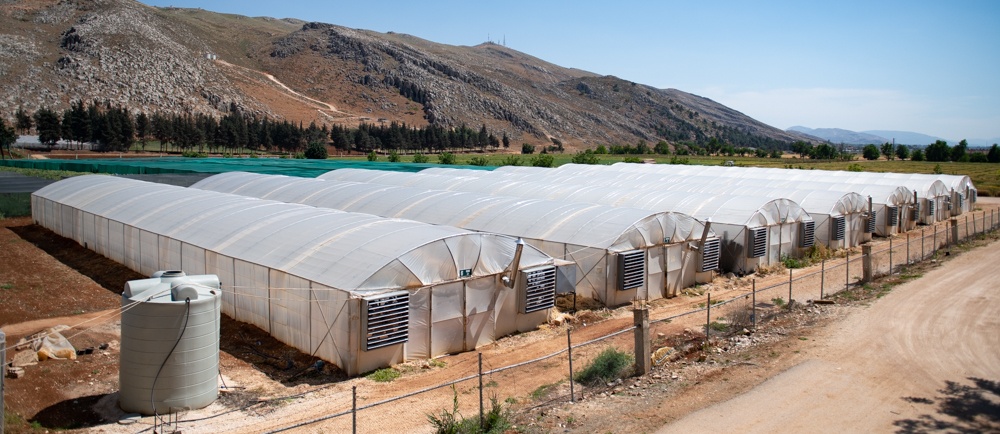
Plastic houses, ICARDA Terbol. (Photo: Michael Major/Crop Trust)
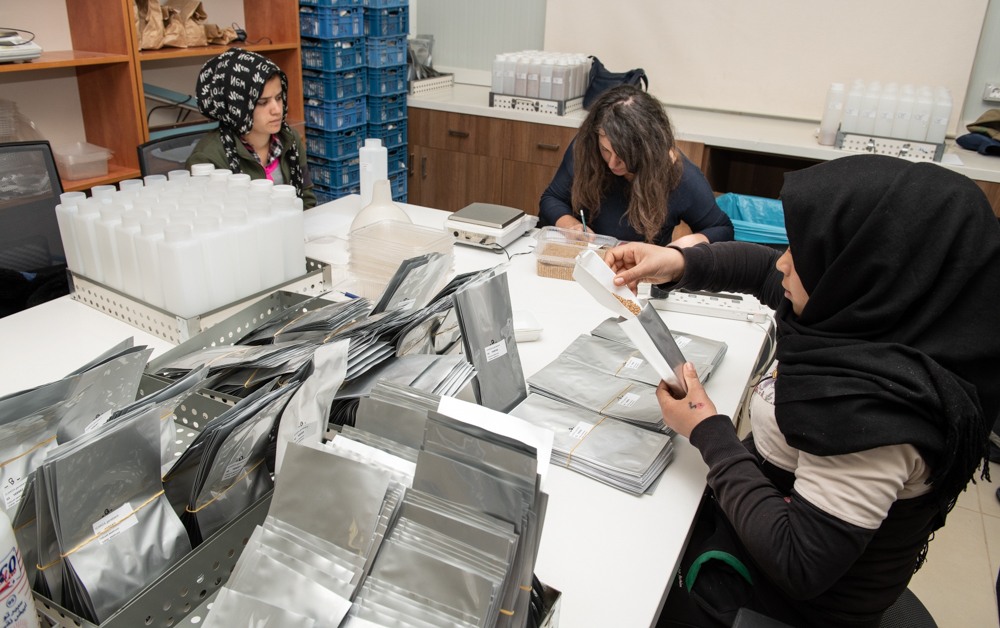
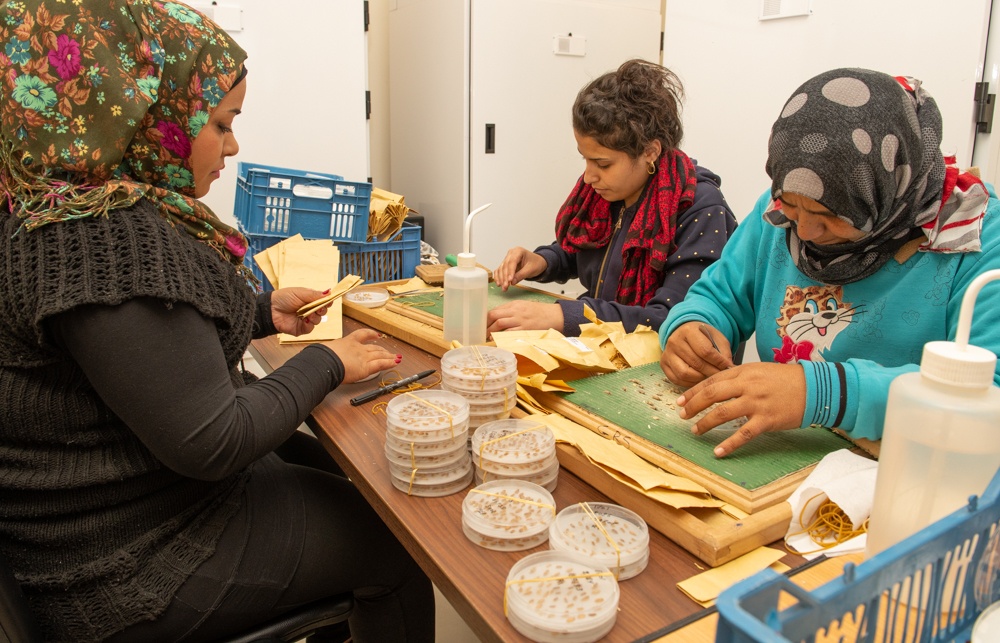
Fatmeh Moussa (left), Mariam Mofid (center) and Zahraa Hussain (right) prepare seed for viability testing at ICARDA Terbol genebank. (Photo: Michael Major/Crop Trust)
Rescue Regeneration Scheme
Sometimes, just getting started is the hardest part of seed regeneration, and some seed samples may require very special treatment. “With some of the seeds we regenerate, particularly the crop wild relatives, we receive only a small sample,” Ali said. “So, we just can’t make mistakes. We have to ensure those few seeds we do have actually germinate.”
In some cases, the seeds require a big kickstart to break dormancy and start germination. “For those, we use a special protocol called ‘rescue regeneration scheme’,” Ali said. “Some species need a chemical treatment, so we might apply hormones, like gibberellic acid, to break the dormancy. With others, we’ll use a thermal treatment or a mechanical treatment, like scarifying the seed with sandpaper or a sharp scraper.”
Once germination has started, the seeds still have to be treated like new-born babies. “We put the seeds in petri dishes in an incubator and then transplant them into small pots so that they can put on a spurt of growth, before transferring them again into larger pots in the plastic houses.”
Power in the People
It’s great to have the science and facilities to multiply seeds, but those are worthless without skilled staff. The expertise in ICARDA has developed over 40 years, with senior staff passing down their knowledge and experience to their younger colleagues, who will take over one day. The shift of the genebank operations from Syria to Lebanon, however, threatened to create an erosion of those human resources. Fortunately, many of the Syrian staff followed the Center to Lebanon.
Fawzi Sweid joined ICARDA as a research assistant in 1978, just a year after the Center was established in Syria. “Fawzi has 35 years of experience in characterization and evaluation of forages. In that time, he has developed a keen eye for forages – something that you can only develop after many years on the job.”
Fawzi is passing on that experience to younger plant genetic resources scientists, like Bachir Al-Awar. “For two years, I have been working with Bachir and passing on my experience, step by step,” Fawzi said. “The work will be in good hands; Bachir is very clever and assertive and good at supervising others. When you get such dedicated staff on your team, you do all that you can to keep them.”
Conserving Crop Diversity Forever
The right location, people and protocols. ICARDA has them all, and is ensuring that the genetic diversity of the food crops and forages from one of the most important centers of agriculture are conserved in the best possible conditions.
This article was originally published by the CGIAR Genebank Platform, a project which ran from 2017 to the end of 2021. It enabled CGIAR Research Centers to fulfill their legal obligation to conserve and make available 750,000 seed samples of crops and trees on behalf of the global community under the International Treaty on Plant Genetic Resources for Food and Agriculture. The Platform supported day-to-day genebank operations, and activities to improve efficiency, enhance use and ensure compliance with international policy. This work was supported jointly by donor contributions to the CGIAR Fund and the Crop Trust Endowment Fund.
Categories: Crop Wild Relatives, Wheat

